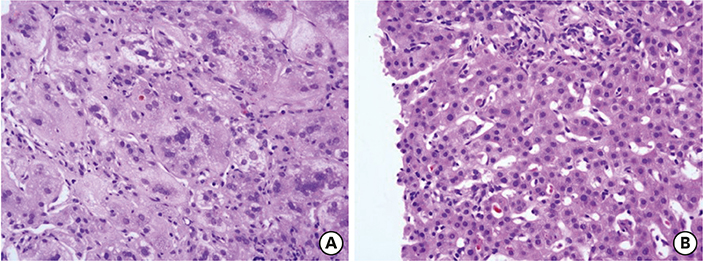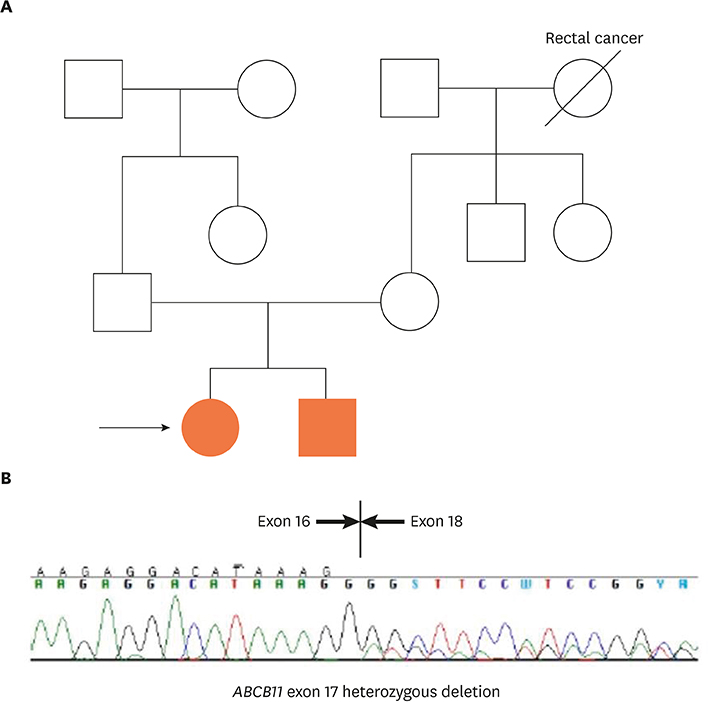Pediatr Gastroenterol Hepatol Nutr.
2019 Mar;22(2):201-206. 10.5223/pghn.2019.22.2.201.
Benign Recurrent Intrahepatic Cholestasis Type 2 in Siblings with Novel ABCB11 Mutations
- Affiliations
-
- 1Department of Pediatrics, Seoul National University College of Medicine, Seoul, Korea. kojs@snu.ac.kr
- 2Department of Laboratory Medicine, Seoul National University College of Medicine, Seoul, Korea.
- 3Department of Pathology, Seoul National University College of Medicine, Seoul, Korea.
- KMID: 2440595
- DOI: http://doi.org/10.5223/pghn.2019.22.2.201
Abstract
- Benign recurrent intrahepatic cholestasis (BRIC), a rare cause of cholestasis, is characterized by recurrent episodes of cholestasis without permanent liver damage. BRIC type 2 (BRIC2) is an autosomal recessive disorder caused by ABCB11 mutations. A 6-year-old girl had recurrent episodes of jaundice. At two months of age, jaundice and hepatosplenomegaly developed. Liver function tests showed cholestatic hepatitis. A liver biopsy revealed diffuse giant cell transformation, bile duct paucity, intracytoplasmic cholestasis, and periportal fibrosis. An ABCB11 gene study revealed novel compound heterozygous mutations, including c.2075+3A>G in IVS17 and p.R1221K. Liver function test results were normal at 12 months of age. At six years of age, steatorrhea, jaundice, and pruritus developed. Liver function tests improved following administration of phenylbutyrate and rifampicin. Her younger brother developed jaundice at two months of age and his genetic tests revealed the same mutations as his sister. This is the first report of BRIC2 confirmed by ABCB11 mutations in Korean siblings.
MeSH Terms
Figure
Reference
-
1. Chawla N, Kudesia S. Benign recurrent intrahepatic cholestasis (BRIC) – a case report and review of literature. Internet J Pathol. 2008; 9.
Article2. Geethalakshmi S, Mageshkumar S. Benign recurrent intrahepatic cholestasis: a rare case report. Int J Sci Study. 2014; 2:222–224.3. van Mil SW, van der Woerd WL, van der Brugge G, Sturm E, Jansen PL, Bull LN, et al. Benign recurrent intrahepatic cholestasis type 2 is caused by mutations in ABCB11 . Gastroenterology. 2004; 127:379–384.
Article4. Kagawa T, Watanabe N, Mochizuki K, Numari A, Ikeno Y, Itoh J, et al. Phenotypic differences in PFIC2 and BRIC2 correlate with protein stability of mutant Bsep and impaired taurocholate secretion in MDCK II cells. Am J Physiol Gastrointest Liver Physiol. 2008; 294:G58–67.
Article5. Adzhubei I, Jordan DM, Sunyaev SR. Predicting functional effect of human missense mutations using PolyPhen-2. Current protocols in human genetics. Hoboken (NJ): John Wiley & Sons, Inc.;2013.6. Schwarz JM, Rödelsperger C, Schuelke M, Seelow D. MutationTaster evaluates disease-causing potential of sequence alterations. Nat Methods. 2010; 7:575–576.
Article7. Summerskill WH, Walshe JM. Benign recurrent intrahepatic “obstructive” jaundice. Lancet. 1959; 2:686–690.8. Luketic VA, Shiffman ML. Benign recurrent intrahepatic cholestasis. Clin Liver Dis. 2004; 8:133–149.
Article9. van der Woerd WL, van Mil SW, Stapelbroek JM, Klomp LW, van de Graaf SF, Houwen RH. Familial cholestasis: progressive familial intrahepatic cholestasis, benign recurrent intrahepatic cholestasis and intrahepatic cholestasis of pregnancy. Best Pract Res Clin Gastroenterol. 2010; 24:541–553.
Article10. Strautnieks SS, Byrne JA, Pawlikowska L, Cebecauerová D, Rayner A, Dutton L, et al. Severe bile salt export pump deficiency: 82 different ABCB11 mutations in 109 families. Gastroenterology. 2008; 134:1203–1214.
Article11. Keitel V, Burdelski M, Warskulat U, Kühlkamp T, Keppler D, Häussinger D, et al. Expression and localization of hepatobiliary transport proteins in progressive familial intrahepatic cholestasis. Hepatology. 2005; 41:1160–1172.
Article12. Noe J, Kullak-Ublick GA, Jochum W, Stieger B, Kerb R, Haberl M, et al. Impaired expression and function of the bile salt export pump due to three novel ABCB11 mutations in intrahepatic cholestasis. J Hepatol. 2005; 43:536–543.
Article13. Richards S, Aziz N, Bale S, Bick D, Das S, Gastier-Foster J, et al. Standards and guidelines for the interpretation of sequence variants: a joint consensus recommendation of the American College of Medical Genetics and Genomics and the Association for Molecular Pathology. Genet Med. 2015; 17:405–424.
Article14. Knisely AS, Strautnieks SS, Meier Y, Stieger B, Byrne JA, Portmann BC, et al. Hepatocellular carcinoma in ten children under five years of age with bile salt export pump deficiency. Hepatology. 2006; 44:478–486.
Article15. Hayashi H, Sugiyama Y. 4-phenylbutyrate enhances the cell surface expression and the transport capacity of wild-type and mutated bile salt export pumps. Hepatology. 2007; 45:1506–1516.
Article16. Balsells F, Wyllie R, Steffen R, Kay M. Benign recurrent intrahepatic cholestasis: improvement of pruritus and shortening of the symptomatic phase with rifampin therapy: a case report. Clin Pediatr (Phila). 1997; 36:483–485.
Article17. Lee SJ, Kim JE, Choe BH, Seo AN, Bae HI, Hwang SK. Early diagnosis of ABCB11 spectrum liver disorders by next generation sequencing. Pediatr Gastroenterol Hepatol Nutr. 2017; 20:114–123.
Article18. Misawa T, Hayashi H, Sugiyama Y, Hashimoto Y. Discovery and structural development of small molecules that enhance transport activity of bile salt export pump mutant associated with progressive familial intrahepatic cholestasis type 2. Bioorg Med Chem. 2012; 20:2940–2949.
Article19. van der Woerd WL, Houwen RH, van de Graaf SF. Current and future therapies for inherited cholestatic liver diseases. World J Gastroenterol. 2017; 23:763–775.
Article20. Gonzales E, Grosse B, Schuller B, Davit-Spraul A, Conti F, Guettier C, et al. Targeted pharmacotherapy in progressive familial intrahepatic cholestasis type 2: evidence for improvement of cholestasis with 4-phenylbutyrate. Hepatology. 2015; 62:558–566.
Article
- Full Text Links
- Actions
-
Cited
- CITED
-
- Close
- Share
- Similar articles
-
- Early Diagnosis of ABCB11 Spectrum Liver Disorders by Next Generation Sequencing
- A case of benign recurrent intrahepatic cholestasis
- Familial Benign Recurrent Intrahepatic Cholestasis
- Phenotypic and Molecular Characteristics of Children with Progressive Familial Intrahepatic Cholestasis in South China
- A Case of Nonfamilial Benign Recurrent Intrahepatic Cholestasis



